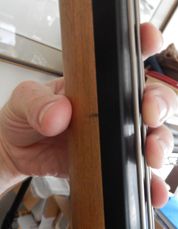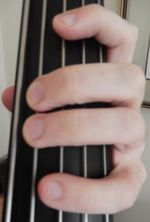One of the biggest hurdles a new Double Bass Student must address in lessons, is the proper hand shape of the left hand. Having the proper hand shape is important for ease of playing but equally importantly intonation. In this article we discuss steps to and techniques to help you achieve an accurate left hand.
Hand Shape and Thumb Location
Let’s start with our basic hand shape and thumb positioning. I instruct my students to make the letter C with their Left Hand and then slide the C onto the neck of the bass. Then work your thumb down towards the floor slightly so it ends up behind your second(middle) finger. We do not want our thumb pointed toward the sky. The other visualization that I find helpful to use is holding a pint glass your thumb warps around the cup. However make sure you are not wrapping your thumb around the bass neck and touching the strings.


Finger Location
The next thing we want to look at is our finger position. Your fingers should be perpendicular to the strings not pointed down towards the floor. If they are pointed towards the floor you will have a very hard time playing in tune because you will for ever be shifting back and forth between notes for intonation. Instead of playing within a set position. There should be an equidistance between the fingers 1-2 and 2-4. Remember as you shift higher up the instrument(towards the floor) your hand frame will shrink and as you go lower your fingers will spread farther apart.

You might be asking yourself what does he mean by “position”? Most upright bass methods divide the fingerboard into numbered positions. So for most bassists they are covering 3 half steps at each hand position up until you reach the octave(or 12 fret for you electric bass players). Different schools have their own names for each “position” the most common used is Half position, 1st position etc. Half Position would be your first(index)finger on the ‘F’ note on the ‘E’ String, 1st Position would be your first(index)finger on the ‘F#’ note on the ‘E’ String and so on.
Shifting
When you shift i.e. move your hand up or down the instrument you want to make sure you bring the thumb with as you shift. So your whole hand is moving as a unit. As you get more comfortable playing the double bass you can start to add what are called “PIVOTS” to your technique. You will pivot using your thumb as an anchor backwards or forwards in order to play a note Half step higher or lower that is not in your current position. We never want to stretch are hand/fingers to reach a note. That unnecessary stretching can lead to injury. The general rule of thumb is to play at least two notes in any given position during a passage.
I hope this give you some insight in to what your Left Hand should look like when playing the upright bass. Remember to slow down time take your time and focus on the technique. Scales and arpeggios are great opportunities to focus on these concepts. A mirror in the practice room also offers great insights into your playing. If you have any questions about the above techniques please feel to contact me via this website. Good Luck and Happy Bass Playing!
1373 Grandview Ave Suite 213 Columbus, OH 43212 (614)262-9586
